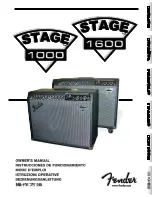
12
Using only piezo
A. Increase the
LEVEL
of Ch1 untill you have a good audible volume.
B. Set the
EQ1
knob to 15 o’clock and search with the corresponding frequen-
cy knob for the most unpleasant frequency. If you are using a piezo it should
be between 12 and 15 o’clock
.
Once you are there, use the
EQ1
knob to
remove it untill the sound is more natural. In most cases placing the
EQ1
knob
at 9 o’clock will do the job.
C. Keep the Level of Ch2 to minimum since you will not use this channel.
D. Adjust your Low - Mid - High from the three band parametric EQ control of
the blended signal to bring the sound to the desired shape.
Handling acoustic feedback tips.
Audio feedback is a special kind of positive feedback which occurs when a
sound loop exists between your mic and the AMP or PA speaker.
The two major parameters that determine the amount of feedback are:
A. the distance from your cabinet/monitor and
B. the volume of your mic.
There are two main frequencies that are most sensitive to feedback. The first
area is the LOW-LOW MID (100Hz-250Hz) and the second area is the MID area
(400Hz-1.5KHz). For the LOW-LOW MID area the
NOTCH
filter is a perfect solu-
tion. For the MID area you can use the low pass shelving button (
)and the
EQ2
knob.
By changing the phase of the blended channel (
ALL
switch) you virtually
move your instrument in to another physical location and therefore you
change the feedback settings.
On stage In-ear Monitoring
You can use your Abox II auxiliary input and headphones output for on stage
in-ear monitoring.
Ask the sound engineer to send a mix to your Auxiliary input and use the Head-
phones out for your own monitoring. The signal on
XLR L+R
and
AMP
outputs is
clean (will not include the signal of the Auxiliary input).
Backtrack Rehearsal
You can use your Abox II auxiliary input and headphones for backtrack re-
hearsal. Connect your auxiliary input min jack to your phone/Ipad/Mp3 player
and play our track. Adjust via XLR L+R the level your instrument and enjoy the
practice.
Piezo, Feedback, In-ear
Summary of Contents for Acoustic Box II
Page 1: ...Acoustic box II Owner s Manual Ver 2 1...
Page 17: ...17 My notes...



































